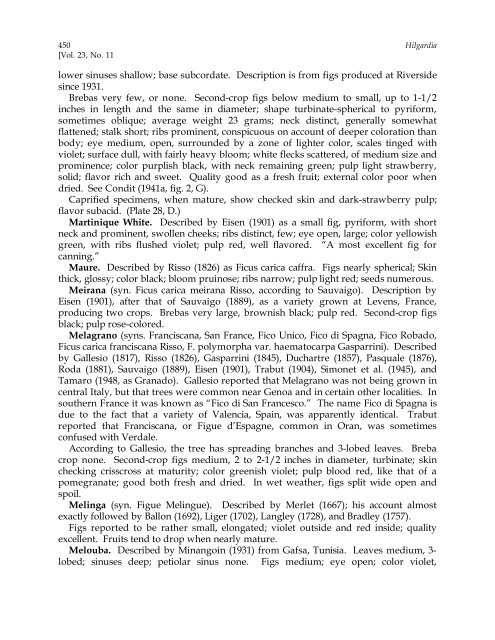Fig Varieties: A Monograph - uri=ucce.ucdavis
Fig Varieties: A Monograph - uri=ucce.ucdavis
Fig Varieties: A Monograph - uri=ucce.ucdavis
Create successful ePaper yourself
Turn your PDF publications into a flip-book with our unique Google optimized e-Paper software.
450 Hilgardia<br />
[Vol. 23, No. 11<br />
lower sinuses shallow; base subcordate. Description is from figs produced at Riverside<br />
since 1931.<br />
Brebas very few, or none. Second-crop figs below medium to small, up to 1-1/2<br />
inches in length and the same in diameter; shape turbinate-spherical to pyriform,<br />
sometimes oblique; average weight 23 grams; neck distinct, generally somewhat<br />
flattened; stalk short; ribs prominent, conspicuous on account of deeper coloration than<br />
body; eye medium, open, surrounded by a zone of lighter color, scales tinged with<br />
violet; surface dull, with fairly heavy bloom; white flecks scattered, of medium size and<br />
prominence; color purplish black, with neck remaining green; pulp light strawberry,<br />
solid; flavor rich and sweet. Quality good as a fresh fruit; external color poor when<br />
dried. See Condit (1941a, fig. 2, G).<br />
Caprified specimens, when mature, show checked skin and dark-strawberry pulp;<br />
flavor subacid. (Plate 28, D.)<br />
Martinique White. Described by Eisen (1901) as a small fig, pyriform, with short<br />
neck and prominent, swollen cheeks; ribs distinct, few; eye open, large; color yellowish<br />
green, with ribs flushed violet; pulp red, well flavored. “A most excellent fig for<br />
canning.”<br />
Maure. Described by Risso (1826) as Ficus carica caffra. <strong>Fig</strong>s nearly spherical; Skin<br />
thick, glossy; color black; bloom pruinose; ribs narrow; pulp light red; seeds numerous.<br />
Meirana (syn. Ficus carica meirana Risso, according to Sauvaigo). Description by<br />
Eisen (1901), after that of Sauvaigo (1889), as a variety grown at Levens, France,<br />
producing two crops. Brebas very large, brownish black; pulp red. Second-crop figs<br />
black; pulp rose-colored.<br />
Melagrano (syns. Franciscana, San France, Fico Unico, Fico di Spagna, Fico Robado,<br />
Ficus carica franciscana Risso, F. polymorpha var. haematocarpa Gasparrini). Described<br />
by Gallesio (1817), Risso (1826), Gasparrini (1845), Duchartre (1857), Pasquale (1876),<br />
Roda (1881), Sauvaigo (1889), Eisen (1901), Trabut (1904), Simonet et al. (1945), and<br />
Tamaro (1948, as Granado). Gallesio reported that Melagrano was not being grown in<br />
central Italy, but that trees were common near Genoa and in certain other localities. In<br />
southern France it was known as “Fico di San Francesco.” The name Fico di Spagna is<br />
due to the fact that a variety of Valencia, Spain, was apparently identical. Trabut<br />
reported that Franciscana, or <strong>Fig</strong>ue d’Espagne, common in Oran, was sometimes<br />
confused with Verdale.<br />
According to Gallesio, the tree has spreading branches and 3-lobed leaves. Breba<br />
crop none. Second-crop figs medium, 2 to 2-1/2 inches in diameter, turbinate; skin<br />
checking crisscross at maturity; color greenish violet; pulp blood red, like that of a<br />
pomegranate; good both fresh and dried. In wet weather, figs split wide open and<br />
spoil.<br />
Melinga (syn. <strong>Fig</strong>ue Melingue). Described by Merlet (1667); his account almost<br />
exactly followed by Ballon (1692), Liger (1702), Langley (1728), and Bradley (1757).<br />
<strong>Fig</strong>s reported to be rather small, elongated; violet outside and red inside; quality<br />
excellent. Fruits tend to drop when nearly mature.<br />
Melouba. Described by Minangoin (1931) from Gafsa, Tunisia. Leaves medium, 3-<br />
lobed; sinuses deep; petiolar sinus none. <strong>Fig</strong>s medium; eye open; color violet,
















![Fig Trees in North Carolina [Archive] - IDigMyGarden ... - Figs 4 Fun](https://img.yumpu.com/26905320/1/190x245/fig-trees-in-north-carolina-archive-idigmygarden-figs-4-fun.jpg?quality=85)